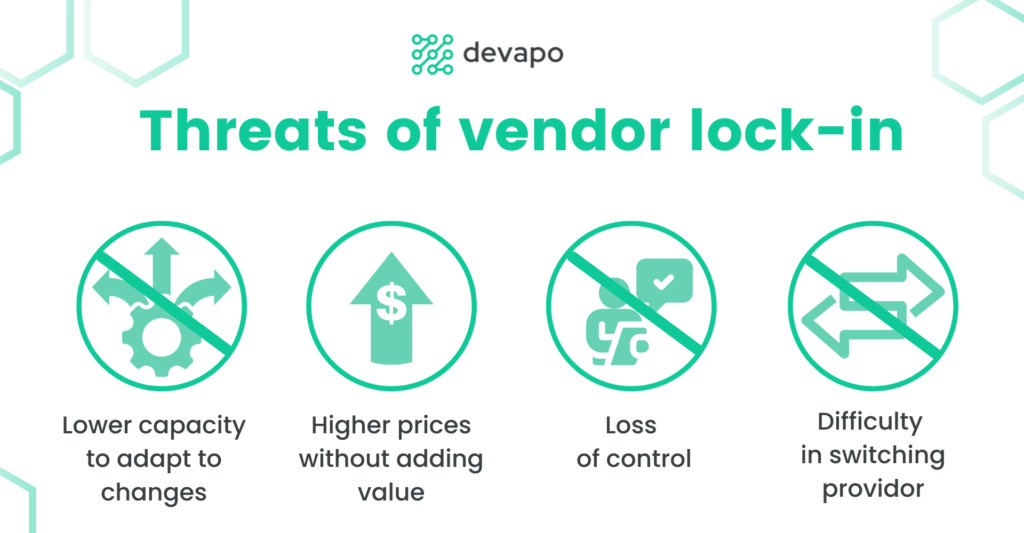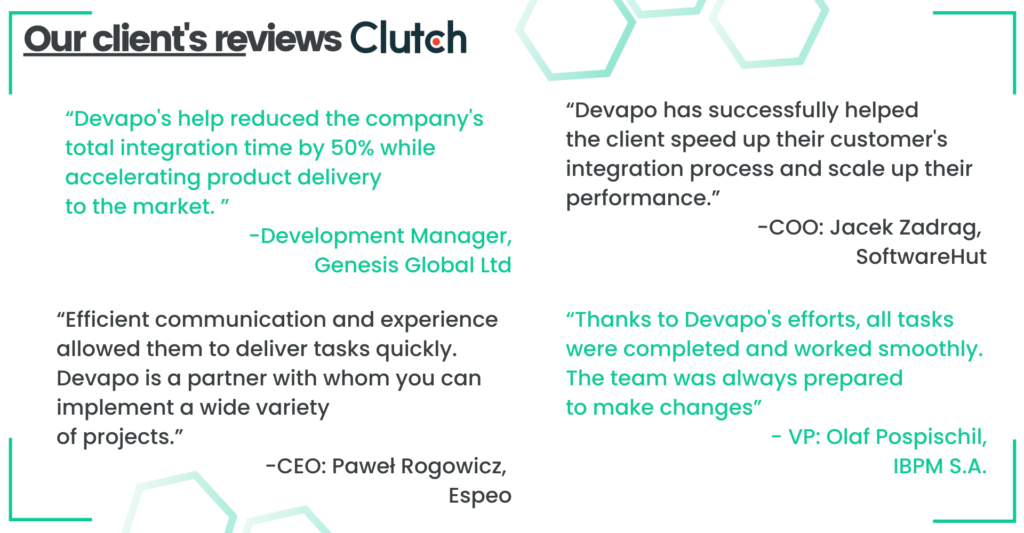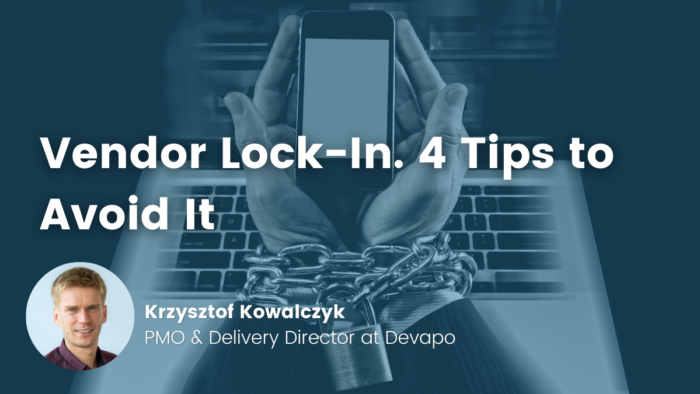- Krzysztof Kowalczyk
- Read in 6 min.
Outsourcing of IT projects and the use of off-the-shelf software are becoming more prevalent as customers are promised increased efficiency, reduced costs and gain a competitive advantage. No wonder that executives are turning to these services, hoping these will help them stay ahead of the curve.
Yet, there are potential downsides to be aware of. The most dangerous being vendor lock-in. It is a common problem facing companies in the technology world. Let me introduce you to the vendor lock-in phenomenon, and its pitfalls. See what you can do to avoid getting stuck in this business trap.
Vendor lock-in in a nutshell
Vendor lock-in occurs when customers become dependent on a particular product or service, making it very difficult and/or financially disadvantageous to change. Unlike building long-term partnerships, vendor dependency may result in limited innovation and flexibility in decision-making. While the first approach can be helpful for sustainable growth and success. That’s why it’s important to be able to distinguish the differences between these relationships. Sometimes, however, this may not be so obvious.
How can you end up in a vendor lock-in?
Falling into the vendor lock-in trap is not that difficult and can happen in several ways.
1. The most common situation regarding products is when a vendor has developed proprietary technology that is incompatible with other systems. The solution itself may provide a lot of out of the box functionality. But, as long as it’s a challenge to integrate it with external systems, your development will be dependent on the vendor and whether they make any necessary modifications or updates.
2. Vendor lock-in can also occur due to a vendor’s failure to adhere to industry standards. In this case, the customer may find it difficult to switch to a different vendor or technology, as they may have to deal with poor quality code and a lack of interoperability.
3. However, not all situations are always on the suppliers’ hands. It can also happen when a party invests significant capital in a supplier’s product or service without controlling the budget. This limits the ability to change without incurring significant costs. If the company cannot afford to do so, it falls into a trap set by itself.
Why is vendor lock-in such a threat?
I don’t think anyone wants to be in a relationship in which one is dependent on another entity, and on top of that it is very difficult to get out of it. And that’s what vendor lock-in means.

It can limit your company’s ability to respond to changing business needs. Especially if the technology or your service provider isn’t reliable, and you can’t be sure it can catch up with new trends. In that case, your business ability to respond to market conditions or take advantage of new technologies may be restricted.
Another threat is when unscrupulous vendors may charge high prices for their products or services without adding benefits. This may happen as they know that you, as a customer, are dependent on them and have limited ability to move on to competitors.
You may wonder, is having a deep partnership with a particular IT vendor really such a bad thing? Well, building lasting partnerships can truly be beneficial. It’s just really important to choose right.
Is it a long-lasting partnership or trap?
A long-lasting partnership is a relationship between two companies that is built on trust, mutual respect, and a shared vision for success. Both parties work together to achieve common goals, and the relationship is characterized by open communication, collaboration, and flexibility. A good vendor will take a truly customer-centric approach.
On the other hand, vendor lock-in is a situation where a company becomes dependent on a particular vendor for products or services, making it difficult or expensive to switch to an alternative vendor. In this scenario, the vendor may have the upper hand and use their leverage to dictate terms or prices, potentially harming the client’s ability to make the best decisions for their business.
4 Tips to Avoid Vendor Lock-In
In the modern business world, vendor lock-in is a common concern for companies that rely on third-party vendors for critical products or services. To avoid the potential risks and costs, executives can take several proactive steps to prevent vendor lock-in. Let me introduce you to the most important ones, in my opinion.
Compare suppliers
The very first step you should take is to evaluate alternatives. Before selecting a vendor, research and compare several options. Get through various offerings, and their lock-in risks. It’s essential to consider a vendor’s reputation. Read reviews and look for case studies they share. A supplier that offers flexible and open solutions, and can easily integrate with other systems can be a great match. Get more tips on how to choose the perfect IT outsourcing partner. I prepared a whole article on that.
Seek for open standards
Open standards are key to avoiding vendor dependency. These standards allow interoperability between different systems, making it easier to switch. When evaluating suppliers, make sure they support open standards and are committed to developing products and services that are compatible with other systems.
This case can be seen here, at Devapo. Our services are driven by open standards. One example that demonstrates this is our involvement in TM Forum Open API Manifesto, which is a set of principles and guidelines for the development of open APIs in the telecommunications industry. Thanks to that, our customers gain solutions that are vendor-neutral, standardized and can be easily integrated into existing systems.
Negotiate contract terms
When negotiating contracts, ensure that there are no long-term commitments and that you have the flexibility to switch vendors. You should also negotiate fair exit terms that allow you to recover your data and avoid penalties if you choose to switch vendors.
Specify scope of support
One way to mitigate the risks of supplier dependency is to find a supplier that focuses its scope of support not only on maintenance, but also on training employees and explaining the technology behind the product.
Meet Devapo’s Values
If you are looking for outsourcing services and want to avoid vendor lock-in, you can count on us. We have strong work ethic that includes:
Cooperation -As a company we have a network of partners, which allows us to access expert knowledge, workshops, and interesting conferences, making our knowledge always up to date. When it comes to tasks and expectations, we count on direct communication to streamline work. We also use an agile approach on projects and work in synergy with our clients.
Professionalism – We complete tasks reliably and on time, and we are highly responsive to needs or complaints.
Proactivity – As a company, we are not afraid of new challenges. Every step of the way we analyze and advise on the best solutions. Thanks to the experience and knowledge we have gained over the years, we constantly find better ways to deal with problems, which allows us to protect our clients from the mistakes of their predecessors.

At the end, let our another partner’s opinion speak for itself that as a company we focus on relationships and getting the job done, not upselling 😉 . Full reviews showing how it is working with us, you can find on our Clutch profile.
Summary
Vendor lock-in can be detrimental to a business, restricting the ability to innovate and adapt to changing market conditions. However, by conducting in depth analysis on vendors, utilizing open standards, negotiating contracts with flexibility, and developing an exit plan, businesses can avoid vendor lock-in. By taking these steps, businesses can ensure that they have access to the latest and most innovative technology, and that they are not subject to price increases or other restrictions imposed by a particular vendor.
Do you want to outsource IT project?
We are here to help you growth










